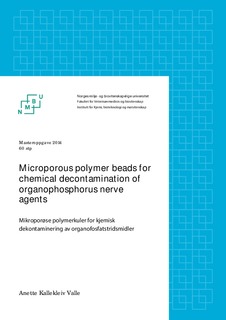| dc.description.abstract | The objective of the work presented in this thesis was the development of reactive polymer beads for use as decontaminants of organophosphorus nerve agents. The physiological mode of action of nerve agents, which is the cause of their high toxicity, is the ability to bind and inhibit the enzyme acetylcholinesterase (AChE). As organophosphorus nerve agents easily reach the active site of AChE and inhibit the enzyme, it was hoped that effective polymeric decontaminants could be prepared by mimicking the structural and functional characteristics of AChE.
In the present study, a suspension polymerization method suitable for polymerization of water-soluble monomers was developed for copolymerization of methyl acrylate and styrene. This method was used for the synthesis of cross-linked poly(methyl acrylate-co-styrene) beads. The established suspension polymerization technique was developed further by incorporation of acid-scavenging monomers into the polymer structure, more specifically 4-vinylpyridine and N-[3-(dimethylamino)propyl]methacrylamide (DMAPMA), entities which were believed to be capable of binding toxic byproducts formed during decontamination. Synthesized polymer products containing these monomers included cross-linked poly(methyl acrylate-co-4-vinylpyridine) and poly(methyl acrylate-co-styrene-co¬-DMAPMA) beads. However, due to low incorporation of DMAPMA and low yields, only cross-linked poly(methyl acrylate-co-styrene) and poly(methyl acrylate-co-4-vinylpyridine) beads were used in further studies as these gave both high incorporation of monomers and consistent, high yields.
The cross-linked poly(methyl acrylate-co-styrene) and poly(methyl acrylate-co-4-vinylpyridine) products were further functionalized with hydroxylamine to convert methyl acrylate moieties to the corresponding hydroxamate anion of hydroxamic acid. In the functionalized product, styrene constitutes the hydrophobic part of the polymer network, contributing to increased affinity of the reactive polymer beads towards the hydrophobic, organophosphorus nerve agents. The converted hydroxamate anions facilitate solvation of the polymer network in aqueous environments, in addition to providing nucleophilic functionalities capable of hydrolyzing the organophosphorus nerve agents. Successful conversion was confirmed by CHN analysis and IR spectroscopy. | nb_NO |

